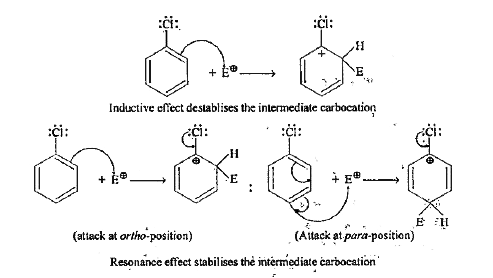Although chlorine is an electron withdrawing group, yet it is ortho-, para-directing in electrophilic aromatic substitution reaction. Why?Solution in Punjabi
Chlorine withdraws electrons through inductive effect and releases electrons through resonance. Through inductive effect, chlorine destabilises the intermediate carbocation formed during the electrophilic substitution.

Through resonance halogen tends to stabilise the carbocation and the effect is, more pronouced at ortho-and para-positions. The inductive effect is stronger than resonance and causes net electron withdrawal and thus causes net deactivation. The resonance effect tends to oppose the inductive effect for the attack at ortho-and para- positions and hence makes the deactivation less for ortho- and para-attack. Reactivity is thus controlled by the stronger inductive effect and orientation is controlled by resonance effect.
Topper's Solved these Questions
- BOOK - BETTER CHOICE PUBLICATIONCHAPTER - GENERAL PRINCIPLES AND PROCESS OF ISOLATION OF ELEMENTS EXERCISE - Question Bank (6.6 OXIDATION-REDUCTION)15videos
GENERAL PRINCIPLES AND PROCESS OF ISOLATION OF ELEMENTS
- BOOK - BETTER CHOICE PUBLICATIONCHAPTER - ORGANIC COMPOUND WITH FUNCTIONAL GROUP CONTANING OXYGEN-IIEXERCISE - Question Bank (12.9 Uses of Carboxylic Acids)4videos
ORGANIC COMPOUND WITH FUNCTIONAL GROUP CONTANING OXYGEN-II
Similar Questions
Name the process from which chlorine is obtained as a bye-product. What will happen if an aqueous solution of NaCl'is:subjected to electrolysis?
01:45View SolutionSodium benzoate is used as a food additive. Why ?
View SolutionHalogens are deactivating yet ortho,para directing in electrophilic aromatic substitution. Which statements do not explain this ?
03:19View Solution(a). Why are alkyl halides insoluble in water?
(b). Why is butan-1-ol optically inactive but butane-2 ol is optically active in nature?
(c). Although chlorine is an electron withdrawing group yet it is ortho para directing in electrophilic aromatic substitution reaction. Why?02:21View Solution(i). Why are alkyl halides insoluble in water. ? (ii). Although chlorine is an electron withdrawing group, yet it is ortho and para directing in electrophilic aromatic substitution.
02:14View Solutionक्लोरीन यद्यपि इलेक्ट्रॉन अपनायक समूह है फिर भी यह ऐरोमैटिक इल्कट्रोनरागी प्रतिस्थापन अभिक्रियाओं में आर्थो-तथा पैरा-निर्देशक है, क्यों?
View SolutionAmino group is ortho-, para-directing for aromatic electrophilic substitution. On nitration of aniline, good amount of m-nitroaniline is obtained. This is due to-
View SolutionWrite short notes on ortho, para directors in aromatic electrophillic substitution reactions.
01:40View Solutionक्लोरीन यधपि इलेक्ट्रॉन आकर्षी समूह है फिर भी यह ऐरोमैटिक इलेक्ट्रॉनस्नेही प्रतिस्थापन अभिक्रियाओं में आर्थो-तथा पैरा-निर्देशक है, क्यों ?
View Solutionक्लोरोबेंजीन के इलेक्ट्रॉन स्नेही ऐरोमैटिक प्रतिस्थापन अभिक्रिया में क्लोरीन की ऑर्थो/पैरा निर्देशक क्षमता निम्नांकित में से किसके कारण होती है
02:21View Solution(a) Why are alkyl halides insoluble in water ? (b) Why is Butan-1- ol optically inactive but Butan-2-ol is optically actove ? (c ) Although chlorine is an electron-withdrawing group, yet it is ortho-para-directing in electrophilic aromatic substitution reactions. Why?
07:49View Solutionक्लोरीन यद्यपि इलैक्ट्रॉन अपचयक समूह है फिर भी यह एरोमैटिक इलैक्ट्रॉनरागी प्रतिस्थापन अभिक्रियाओं मे आर्थो तथा पैरा निर्देशक है, क्यों?
06:40View SolutionThough Chlorine is an electron withdrawing group but it activate the ortho & para position in the benzene ring for electrophilic attack. Explain.
02:56View SolutionExplain why alkoxy group (-OR) is ortho, para directing and activates the aromatic ring towards electrophilic substitution.
02:57View SolutionExplain how the alkoxy group (-OR) is ortho and para-directing and activates the aromatic ring towards electrophilic substitution reactions.
02:38View SolutionAlthough chlorine is an electron withdrawing group, yet is op directing in electrophilic aromatic substitution reaction. Explain.
View Solution

